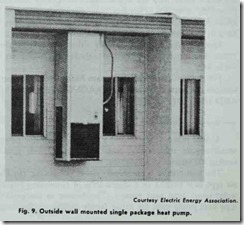ELECTRIC UNIT VENTILATORS
Electric unit ventilators (similar in design to the heaters, see Fig. 7) are used to heat, ventilate, and cool large spaces that are by nature subject to periods in which there will be a high density of occupancy. They are frequently found in offices, schools, auditoriums, and similar structures.
The basic components of a typical unit ventilator are:
1. The housing,
2. Motor and fans,
3. Heating element,
4. Dampers,
5. Filters,
6. Grilles or diffusers.
Automatic controls activate the unit ventilator and vary the temperature of the air discharged into the room in accordance with room requirements. Outdoor air is drawn through louvers in the wall and into the unit ventilator before being discharged into the interior of the structure. These ventilators are usually floor or ceiling mounted depending on the design of the room.
In addition to electricity, unit ventilators may also be gas fired, or use steam or hot water as the heat medium. Unit ventila tors are described in greater detail in Chapter 2, Volume 3 (RA DIATORS, CONVECTORS, AND UNIT HEATERS).
ELECTRIC UNIT HEATERS
Electric unit heaters (Fig. 7) are used primarily for heating large spaces such as offices. garages, warehouses, and similar types of commercial and industrial structures.As is the case with unit ventilators, the heat conveying medium and combustion source may be other than electricity. For example, the air may be heated by either gas-fired or oil-fired units. Steam or hot water can be substituted for air as the heat conveying medium. Selecting electricity as a medium will depend on such factors as:
1. The availability of cheap electrical power,
2. The need for supplementary heating,
3. The scarcity of other heat conveying mediums.
The typical unit heater contains the following basic compon- ents:
1. Fan and motor,
2. Heating element,
3. Directional outlet,
4. Casing or housing.
Unit heaters may be floor mounted or suspended from the ceiling, depending upon the design requirements of the structure.
ELECTRIC SPACE HEATERS
Smaller unit heaters designed and constructed for domestic heating purposes are commonly referred to as space heaters. Like the larger units, they are also designed to operate with other heat conveying mediums. However, the advantage of using electric space heaters over the fuel burning types is that they do not have to be vented and require no flue.
Space heaters are available as either portable or permanent types. The latter can be fitted into ducts or mounted on walls or the ceiling.
For further information on space heaters read the appropriate sections in Chapter 2, Volume 3 (RADIATORS, CONVECTORS, AND UNIT HEATERS).
HEAT PUMPS
A heat pump (Figs. 8 and 9) is an electrically powered, re versible-cycle refrigeration unit capable of both heating and cooling the interior of a structure.
The heat source is commonly either outside air (in the air-to air type heat pump) or a closed loop of circulating water (in the water-to-air type heat pump). The former is the most popular type heat pump used for single family dwellings. The water-to-air heat pump system is most often found in multifamily structures. These are essentially central heating systems, with the heat pump replacing the central furnace or boiler as the heat generating unit.
Operating valves in the heat pump unit control the reversal of the refrigeration cycle. It removes heat from the interior of the structure and discharges it outside during hot weather, and sup plies heat to the interior spaces during periods of cold weather.
The basic components of a heat pump installation are: (1) the compressor, (2) the condenser, (3) the evaporator, and (4) alow-voltage thermostat. These and other aspects of heat pumps are described in greater detail in Chapter 12, Volume 3.
ELECTRIC HEATING AND COOLING CONTROLS
In an electric heating and cooling system, the best results are obtained by finding a comfortable thermostat setting and leaving it there. Constantly changing the thermostat setting will result in consuming more energy (resulting in increased operating costs) and will create additional wear and tear on the equipment. Ex perts estimate that for each degree the thermostat is raised above the normal setting there is a three percent increase in heating costs. A comfortable setting for the thermostat will depend upon a number of variables, including: ( 1) the type of system, (2) environmental conditions, and (3) your personal requirements. For example, 70 degrees is usually adequate for a radiant heating system (i.e. baseboard, panel-type heating installations, etc.) in a properly insulated structure. A comfortable indoor temperature setting for air conditioning is usually 76-78 degrees.
A variety of control methods are used in electric heating and cooling systems to maintain kilowatt demand at a level both economical in operation and suitable in performance. The basic types of controls used for these purposes are:
1. Thermostats,
2. Sequence switching devices,
3. Load-limiting controls,
4. Time-delay relays.
Thermostats can be located in each room or on each heating unit to provide decentralized control. A manual switch can be provided with each thermostat to shut off the current if the room is to be unoccupied for long periods of time.
Sequence switching devices are used to switch electrical cur rent in sequence (rotation) from one room or circuit to the next. A load-limiting control is designed to shut off the current to one or more circuits when total electric demand exceeds a preset value. Time-delay relays are used to restore service after an inter ruption nonsimultaneously over a period of several minutes so that overloading is avoided. Each of these controls is examined in considerable detail in Chapter 14 (ELECTRIC-FIRED FURNACES).

